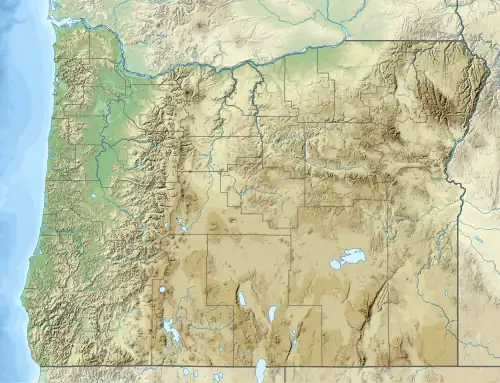Bradley Lake (Oregon)
| Bradley Lake | |
|---|---|
.jpg) Grasses and water lilies at Bradley Lake | |
 Bradley Lake Location of Bradley Lake in Oregon, USA.  Bradley Lake Bradley Lake (the United States) | |
| Location | Coos County, Oregon |
| Coordinates | 43°03′56″N 124°25′38″W / 43.06556°N 124.42722°W |
| Primary outflows | China Creek (Oregon) |
| Catchment area | 6.46 km2 (2.49 sq mi)[1] |
| Basin countries | United States |
| Surface area | 23 acres (9.3 ha)[1] |
| Average depth | 23 ft (7.1 m)[1] |
| Max. depth | 33 ft (10.2 m)[1] |
| Water volume | 655,963 km3 (157,374 cu mi) |
| Shore length1 | 1 mi (1.6 km)[1] |
| Surface elevation | 23 ft (7.0 m)[2] |
| 1 Shore length is not a well-defined measure. | |
Bradley Lake is a natural lake on the Oregon Coast in Coos County, Oregon, United States, about 4 miles (6.4 km) south of Bandon. Its surface area is 23 acres (9.3 ha).[1] It is a popular fishing spot for rainbow trout.[3]
Bradley Lake was formed when coastal sand dunes blocked the exit of China Creek, flooding a depression, and accumulating about twenty feet of sediment. The lake has been protected from storm surges, but not tsunami waves, which dumped sand and salt water. Kelsey et al discovered evidence of seventeen such events, after radiocarbon dating of core samples, over a 4600 year period within the Cascadia subduction zone.[4][5]
References
- ^ a b c d e f "Bradley Lake (Coos)". Atlas of Oregon Lakes. Portland State University. Retrieved December 22, 2014.
- ^ "Bradley Lake". Geographic Names Information System. United States Geological Survey, United States Department of the Interior. November 28, 1980. Retrieved December 22, 2014.
- ^ Bradley Lake - Fish Reports & Map, norcalfishingreports.com. Retrieved May 26, 2025.
- ^ Kelsey, Harvey; Nelson, Alan; Hemphill-Haley, Eileen; Witter, Robert (2005). "Tsunami history of an Oregon coastal lake reveals a 4600 yr record of great earthquakes on the Cascadia subduction zone" (PDF). wou.edu. Geological Society of America Bulletin. Retrieved 15 August 2025.
- ^ Macdougal, Doug (2008). Nature's Clocks: How Scientists Measure the Age of Almost Everything. Berkeley: University of California Press. pp. 200–203. ISBN 9780520261617.